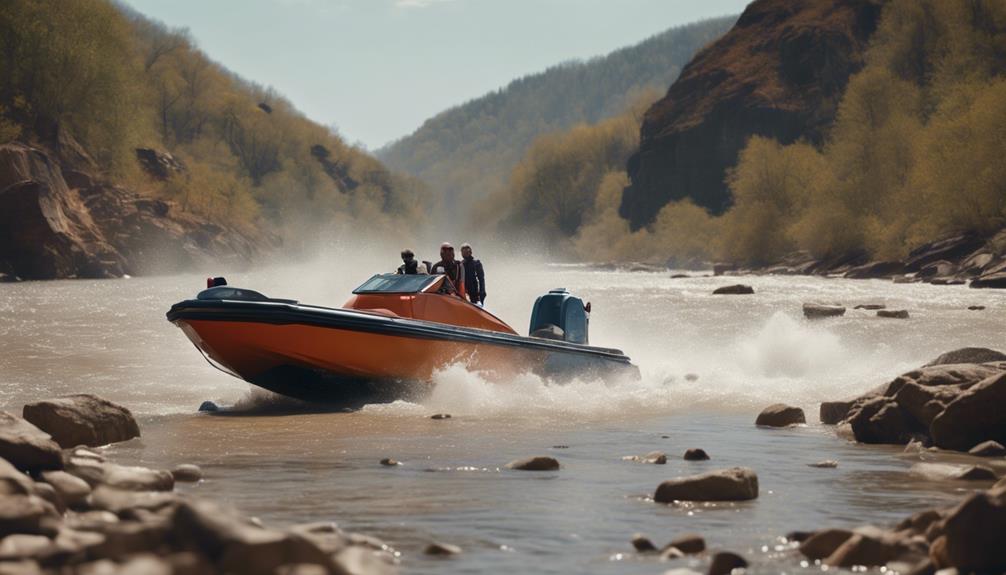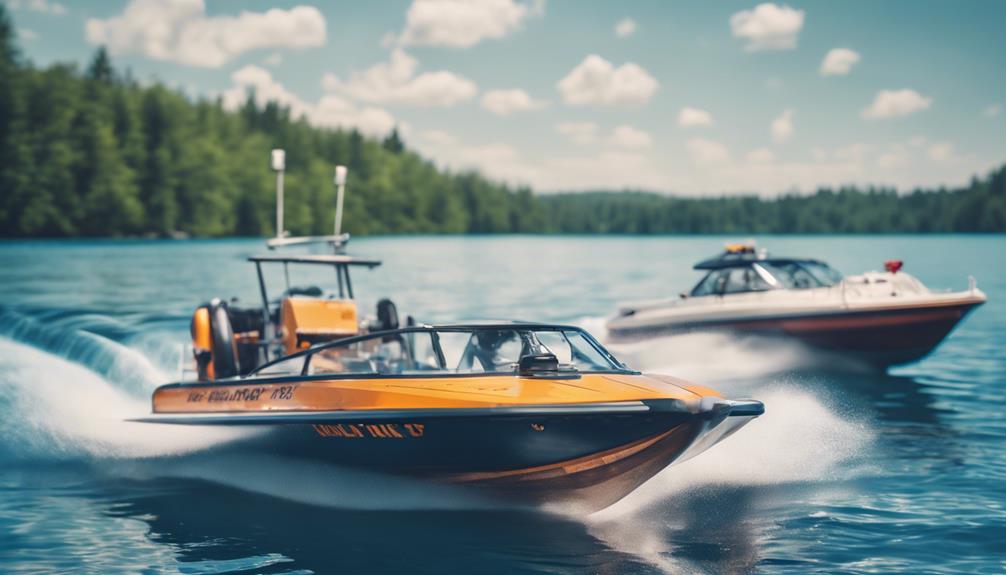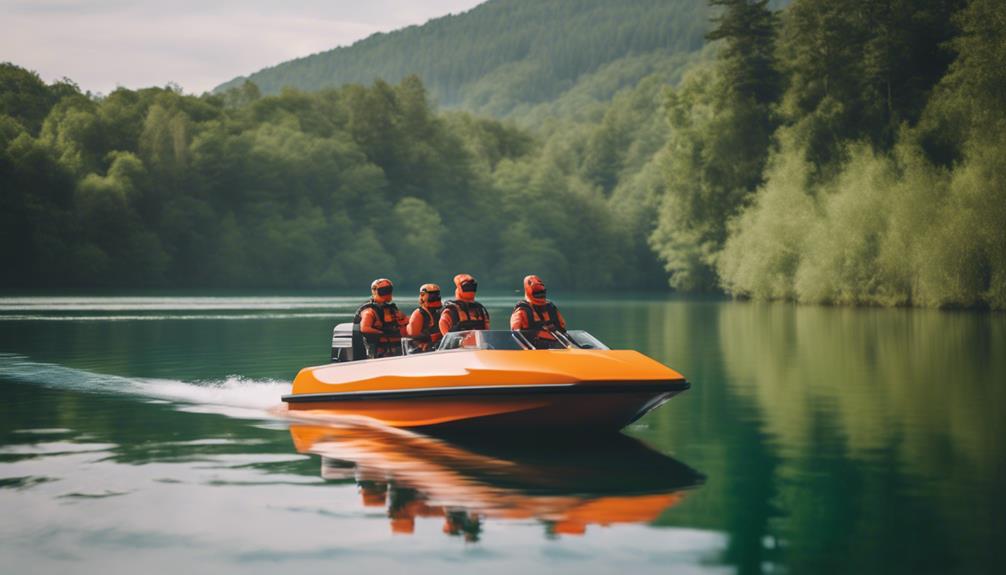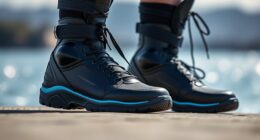Jet boats need at least 7.5 cm (3 inches) of water to operate, which lets you cruise through shallow rivers and lakes with ease. For peak performance, aim for a water depth of around 30 cm (12 inches). You'll want to maintain a consistent flow to the impeller, as blockages in the water intake can impact thrust and maneuverability. Operating in too shallow water can lead to overheating and damage. Remember, understanding your jet boat's water requirements enhances your safety and fun on the water. Want to explore more about keeping your jet boat in top shape?
Key Takeaways
- Jet boats can operate in as shallow as 7.5 cm (3 inches) of water, making them suitable for rivers and lakes.
- For peak performance, a minimum water depth of 30 cm (12 inches) is recommended.
- A consistent water flow is crucial for thrust and control during operation.
- Insufficient water can lead to impeller overheating, engine damage, and reduced maneuverability.
Jet Boat Water Requirements
When it comes to jet boats, understanding their water requirements is vital for ideal performance and safety on the water.
Jet boats utilize a jet drive system that draws water from beneath the hull, relying on waterjet propulsion to generate thrust. This unique design allows them to operate effectively in very shallow waters, as little as 7.5 cm (3 inches).
However, to maintain peak performance, you need to guarantee a consistent flow of water to the impeller. A blockage in the water intake can greatly impair your boat's performance, leading to decreased thrust and maneuverability.
For instance, a jet boat equipped with a 230 mm inlet diameter and a 200 hp engine can achieve an impressive flow rate of approximately 0.3 m³/sec (18,000 liters/min). This highlights just how important an adequate water supply is for propulsion.
Importance of Water Depth

Understanding the importance of water depth is essential for jet boat operators to guarantee peak performance and safety. Jet boats can operate in water as shallow as 7.5 cm (3 inches), which makes them perfect for traversing rivers and lakes that other boats can't access. However, while their shallow draft allows for this flexibility, it's important to be aware of how water depth can impact your experience.
In high-speed conditions, consistent water depth is necessary for maintaining thrust and control. Shallow water can greatly affect your boat's performance and maneuverability, especially when quick turns or sudden stops are required. Unlike propeller-driven boats, jet boats don't have protruding components below the hull, making them safer for traversing shallow waters with submerged hazards.
Additionally, the intake grate plays a significant role in preventing debris from entering the jet unit, especially in shallow, rocky environments where obstructions are common. Knowing the water depth helps you avoid grounding and guarantees that your jet boat operates at its best.
Ultimately, being mindful of water depth not only enhances your jet boating experience but also keeps you and your passengers safe on the water.
Factors Affecting Water Needs

Water needs for jet boats vary based on several factors, including hull design, intake size, and environmental conditions.
The hull design plays a vital role in determining how well your jet boat performs in different water depths. For instance, boats with larger intakes require deeper water to function effectively, while others can operate in as little as 7.5 cm (3 inches).
The performance of jet drives is also influenced by the flow rate and pressure of the water being drawn in. A specific water depth is necessary for peak propulsion, so ensuring that you're in the right conditions is key.
Additionally, environmental factors like water temperature and turbidity can impact your boat's efficiency. Warmer or murkier waters can hinder intake effectiveness, reducing thrust and overall performance.
Lastly, don't overlook the importance of regular maintenance of the intake grate. Debris can block water flow, severely limiting your jet boat's operational capacity.
Ideal Conditions for Jet Boats

For jet boats to truly shine, they thrive in depths of at least 30 cm (12 inches) where they can achieve peak performance and maneuverability. While these boats can operate in as little as 7.5 cm (3 inches), the ideal conditions for peak performance really come into play with deeper waters. In such depths, jet boats can reach high speeds and exhibit exceptional agility, making your experience more thrilling.
The unique hull design of jet boats considerably reduces drag, allowing them to glide smoothly even in varying water conditions, provided there's enough depth to prevent the intake from running aground. A steady flow of water to the intake is vital; disruptions from debris or sudden changes in water depth can hinder engine operation and thrust, which is something you want to avoid.
When you find yourself in ideal conditions, you'll notice how jet boats maneuver effortlessly over obstacles, outperforming traditional propeller boats. So, seeking out deeper waters not only enhances your boating experience but also guarantees your jet boat operates at its best.
Risks of Low Water Levels

Operating a jet boat in low water levels poses several risks that can jeopardize your safety and the boat's performance. When the water dips below the recommended levels, your jet boat may struggle with reduced maneuverability and overall efficiency. Insufficient water intake can lead to the impeller running dry, which risks overheating and potentially damaging your engine.
Moreover, as you navigate shallow waters, the likelihood of debris entering the intake increases. This debris can clog the system, impairing your boat's performance and responsiveness. You also face the risk of hull strikes or grounding, which can not only damage your jet but also create safety hazards for you and your passengers.
Additionally, remember that jet boats rely on a constant flow of water for thrust and steering. When water levels are low, you might experience a momentary loss of control, particularly during high-speed maneuvers.
To guarantee a safe and enjoyable experience, always check water levels before heading out and avoid operating your jet boat in conditions that could compromise your safety or the integrity of your vessel.
Comparison With Other Boats

Steering through shallow waters highlights the advantages of jet boats compared to traditional vessels, particularly in their ability to operate efficiently in minimal depths.
While jet boats can glide through just 7.5 cm (3 inches) of water, conventional boat types typically require at least 30-60 cm (12-24 inches) to avoid damaging their propellers. This significant difference means you can explore areas where traditional boats can't venture.
The water jet propulsion system used in jet boats draws a jet of water from beneath the hull, allowing for clean maneuvering without the risk of grounding. In contrast, inboard/outboard (I/O) boats have protruding components that can easily get obstructed in shallow waters, limiting their accessibility.
Additionally, jet boats excel in high-speed performance even in these shallow conditions, reaching speeds of up to 50 knots. Traditional boats, on the other hand, often face increased drag and reduced efficiency when maneuvering similar depths.
Maintenance Tips for Jet Boats

To keep your jet boat running smoothly, you need to focus on a few key maintenance tasks.
Regularly inspect the impeller and clean the intake grate to prevent performance issues.
Also, monitor your engine's performance closely to catch any potential problems early on.
Regular Impeller Inspection
Regularly inspecting the impeller is vital for keeping your jet boat performing at its best. The impeller plays an important role in drawing water into the jet drive and generating thrust, so any issues can lead to performance problems. You should look for signs of wear, damage, or debris accumulation on the impeller blades. These factors can greatly impact your boat's efficiency and speed.
It's recommended that you inspect the impeller at least once per season or after any considerable use in shallow or debris-rich waters. This proactive maintenance can help you avoid costly repairs down the line. If you spot any damage or excessive wear, consider cleaning the impeller or replacing it to guarantee peak performance.
To get the best results, always consult your manufacturer's guidelines for specific inspection intervals and maintenance practices tailored to your jet boat model and impeller type.
Clean Intake Grate
Keeping the intake grate clean is critical for guaranteeing ideal water flow and preventing unnecessary strain on your jet boat's engine. Regular inspections are important; debris like plastic bags or vegetation can greatly impair performance and fuel efficiency. When you notice any blockages, it's time to take action.
Here's a quick guide to help you maintain a clean intake grate:
| Maintenance Task | Frequency |
|---|---|
| Inspect for debris | Before each use |
| Clean the grate | Every few outings |
| Check for damage | Monthly |
To clean the intake grate, simply remove it and wash it with fresh water to eliminate accumulated debris. A well-maintained intake grate allows your jet boat to operate efficiently, especially in shallow waters where performance can be compromised by obstructions. Don't forget to verify that the intake grate is securely attached and free from damage. This will help prevent water flow disruptions that could lead to engine overheating or reduced thrust. Keeping your jet boat's intake grate clean is a small but essential step to guarantee smooth sailing and optimal performance.
Monitor Engine Performance
Monitoring your engine's performance is vital for ensuring your jet boat runs smoothly and efficiently. Start by regularly checking your engine's RPMs to confirm they stay within the ideal range. Excessive RPMs can lead to increased wear and potentially damage your engine over time.
Next, monitor your fuel consumption rates and intake efficiency. Disruptions to the water flow through the jet unit can negatively impact both engine performance and fuel efficiency. Inspect the intake grate often for debris, as blockages can hinder the engine's ability to draw in water, reducing thrust and risking overheating.
It's important to schedule routine maintenance every 50-100 hours of operation. Focus on the impeller, drive shaft, and cooling system to maintain peak engine performance.
Additionally, always use high-quality fuel and lubricants—these can help prolong engine life while improving overall performance by reducing deposits and enhancing combustion efficiency.
Safety Measures for Navigation

Ensuring safe navigation in a jet boat involves understanding its unique design advantages and maintaining the intake grate to prevent debris blockage. Jet boats excel in shallow waters, as they can operate in just 7.5 cm (3 inches) of water. This makes them perfect for exploring rivers and lakes. Their design also minimizes risks; with no protruding parts, you reduce the chance of hull strikes and enhance swimmer safety.
Here are some key safety measures to keep in mind:
| Safety Feature | Benefit |
|---|---|
| Crash Stops | Allow quick halting in emergencies |
| Sharp Turns | Enable rapid maneuverability |
| Low Hull Profile | Reduces risk to marine life |
Regular inspections of the intake grate are essential. Blockages can impair performance and safety during navigation, so make it a habit to check it often. By prioritizing these safety measures, you'll enjoy a safer and more enjoyable jet boating experience. Always remember that your awareness and preparation are important for safe navigation on the water.
Best Practices for Jet Boating

What practices can you adopt to enhance your jet boating experience and assure efficient maneuvering?
First, regularly inspect and clean the intake grate on your jet boat. This prevents debris from clogging the system, which can greatly impair performance and efficiency.
Utilizing reverse thrust is another best practice; by lowering a deflector into the jetstream, you gain better control at low speeds, making docking and maneuvering tight spaces much easier.
Additionally, verify that your engine and jet unit are properly matched. This optimization can improve fuel efficiency, reducing operational costs in the long run.
You should also practice advanced maneuvering techniques, like Hamilton turns and crash stops. These skills will help you fully utilize the superior handling capabilities of your jet boat in various water conditions.
Lastly, always be mindful of the shallow water capabilities of your jet boat. They can operate in as little as 7.5 cm (3 inches) of water, allowing for exploration in areas where traditional boats struggle.
Frequently Asked Questions
How Much Water Does a Jet Boat Need?
When considering a jet boat's water needs, you'll want to guarantee the intake's clear for ideal performance. Generally, it can operate in as little as 7.5 cm, but consistent water flow is essential.
How Much Water Does a Jet Ski Need?
Like a fish needs water, you need at least 3 feet for your jet ski to operate safely. Shallow depths can limit performance, so always check conditions before you hit the waves.
How Many Gallons per Hour Does a Jet Boat Use?
A jet boat typically uses between 10 to 30 gallons of fuel per hour, depending on engine size, speed, and water conditions. You'll want to take into account these factors for ideal performance and efficiency.
Are Jet Boats Good in Shallow Water?
Imagine a sleek dolphin gliding effortlessly through shallow waters; that's what jet boats do. They're perfect for maneuvering tight spots, executing sharp turns, and overcoming obstacles, making them excellent for shallow water adventures.
Is the Beach Rider Jet Boat Suitable for the Amount of Water Needed for Jet Boating?
The beach rider jet boat cost may vary, but its suitability for the amount of water needed for jet boating is unparalleled. With its powerful engine and agile design, the beach rider jet boat can easily navigate various water conditions, making it an ideal choice for thrilling jet boating experiences.
Conclusion
In the world of jet boating, knowing how much water you need is like having a compass guiding you through uncharted waters.
By understanding the importance of water depth and ideal conditions, you can navigate safely and enjoy the thrill of the ride.
Remember to keep an eye on the water levels and maintain your boat diligently.
With these practices in mind, you'll glide smoothly across the surface, ready for adventure at every turn!










